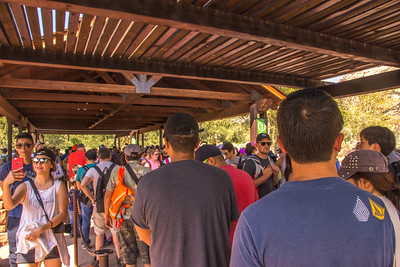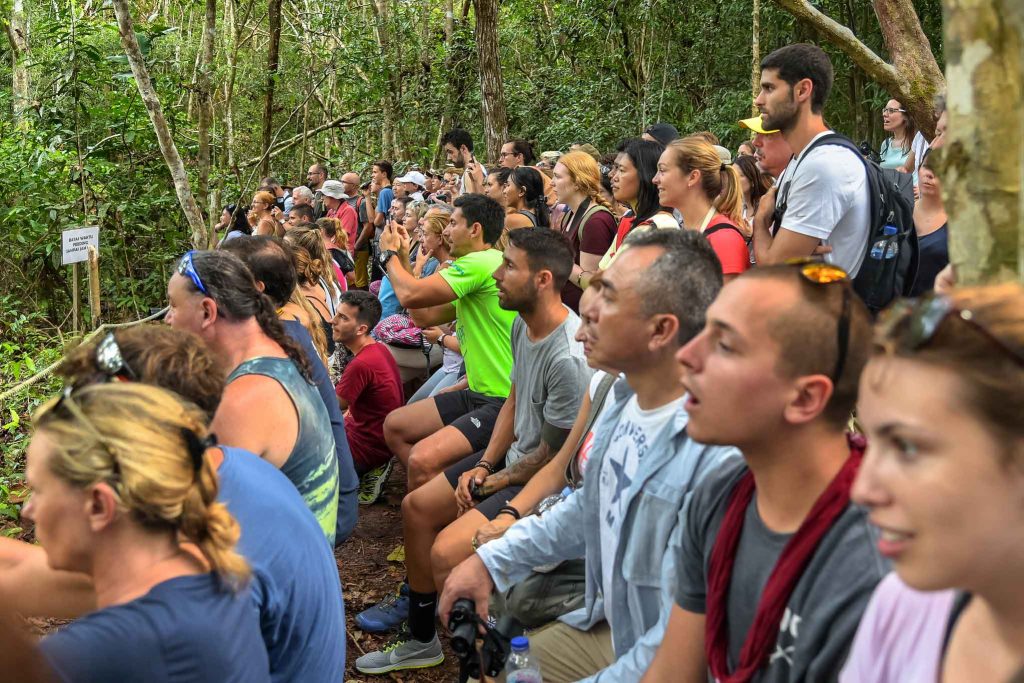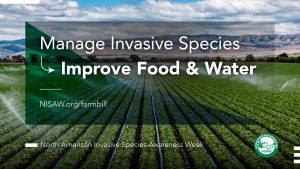This article on park visitors and invasive species was originally posted on the blog of NAISMA’s program PlayCleanGo on August 20, 2019. It has been lightly edited for the North American Invasive Species Management Association.
Whether you paddle board, mountain bike, hike, or fish, you have experienced visitor management tools.
Water access, trail, and parking design all are visitor management. Signs, interpretive talks, trifold pamphlets, and campground hosts also are visitor management. We look at issues like wildfires, littering, wildlife harassment, and crowding through the lens of the park visitor, so why not invasive species?
The Framework
Many agencies are already using visitor management tools like boot brush kiosks and boat checking stations. With the release of the interagency visitor use management framework (the framework) in 2016, land management agencies that are trying to prevent invasive species now have a tool to apply visitor use management. In 2019 the Minnesota Department of Natural Resource (DNR) began to use the framework to find the most effective way to prevent invasive species on state forest lands.
While the National Park Service is using the framework to tackle difficult problems like overcrowding at Zion National Park, your agency does not need to have millions of visitors from around the world to find the framework helpful. The beauty of the framework is that it can scale. For the DNR, the framework helped us look at invasive species on state forest land with fresh eyes, and provided a tested method for addressing invasive species spread by visitors.

Understand Your Site and Visitors
The process begins with understanding the site and its visitors. We found that we know a lot about the invasive species in our state forests but less about the people who visit. Before thinking about solutions, we had to understand our visitors: where are they going and what are they doing while visiting? We are currently collecting this data using trail counters and observations; we will also use trail intercept surveys. Once we understand visitor use we can begin to determine which strategies will work to prevent visitors from spreading invasive species.

Determine Your Goals for Your Site
The second part of the framework defines the land’s desirable conditions.
This can vary greatly from site to site, but for PlayCleanGo it will likely be something along the lines of “no more than three invasive plants found along the trail and no newly introduced invasive plants.”
Once desired conditions are met, you can set indicators and thresholds that will show whether your strategies are working. An example of an indicator would be the number of new invasive plants introduced; a threshold would be the total number of invasive plants introduced over time. By setting these thresholds before implementing strategies, you have set point where you must change your strategies.
Create Prevention Strategies for Reaching Your Site or Park Visitors
The next part of the framework creates strategies for invasive species prevention. You must tailor your invasive species prevention strategies to your site or park visitors (so don’t skip Step1: Understanding Your Site and Visitors). Local visitors who do not read trailhead signs will require a different strategy than equestrian users who visit your site from out of state.
Watch the Webinar on Making Educational Signage That People Actually Read
This is a good time to think about design: where visitors naturally stop while at your site is likely a good location to place PlayCleanGo tools. The key during this phase is to think of your solution through the eyes of your visitor.
Observe and Adjust for Best Results
The most important part of the framework is also the last part: monitoring, evaluating and adjusting.
Even though you might have done everything right, it still might not work—people may not be reading your signs, they may be going off trail, or they could be dumping bags of invasive seeds at the trailhead.
There is no way to know whether your strategies are working unless you conduct regular, ongoing monitoring. Check your indicators from Part 2 (Determine Your Goals) regularly, and adjust your strategies if indicators fall below the set thresholds. By monitoring and evaluating your strategies, you can remain on top of invasive species prevention.
More Resources:
- PlayCleanGo offers great invasive species prevention tools for agencies and managers, but you must use these tools in a way that engages your visitors. Installing the same boot brush sign at every trail will not work well.
- The interagency visitor use management framework provides a tested process that can be modified and scaled for your site and will help ensure that the implementation of PlayCleanGo strategies will be effective for reaching park visitors, conservation area users, and more members of the public, wherever your site is.
- Have questions? Join this blog author and June webinar presenter Forest Eidbo on July 10, 2020, for Virtual Networking—a monthly series only open to members. Grab lunch (Pacific time zones) or a coffee (looking at you, Hawaii) and meet like-minded professionals from around North America. This month, we’re following up with Forest. If you missed his webinar, you can watch it as a member here.
- Learn about how NAISMA is working with the National Park Service, Wildlife Forever, and the US Fish and Wildlife Service to enhance coordination of invasive species prevention messaging across public lands and waters.
Featured image photo by Flicker user Jorge Franganillo under CC BY 2.0.

Forest Eidbo
Forest Eidbo is the Terrestrial Invasive Species Prevention Specialist for the Minnesota Department of Natural Resource Division of Forestry. He worked as park ranger for the Army Corps of Engineers and National Park Service before coming to the DNR. He holds a master’s of science in natural resource science and management where he focused on developing effective signage strategies for managing visitors to public lands.




